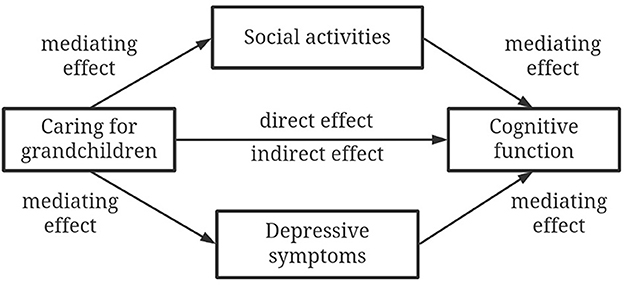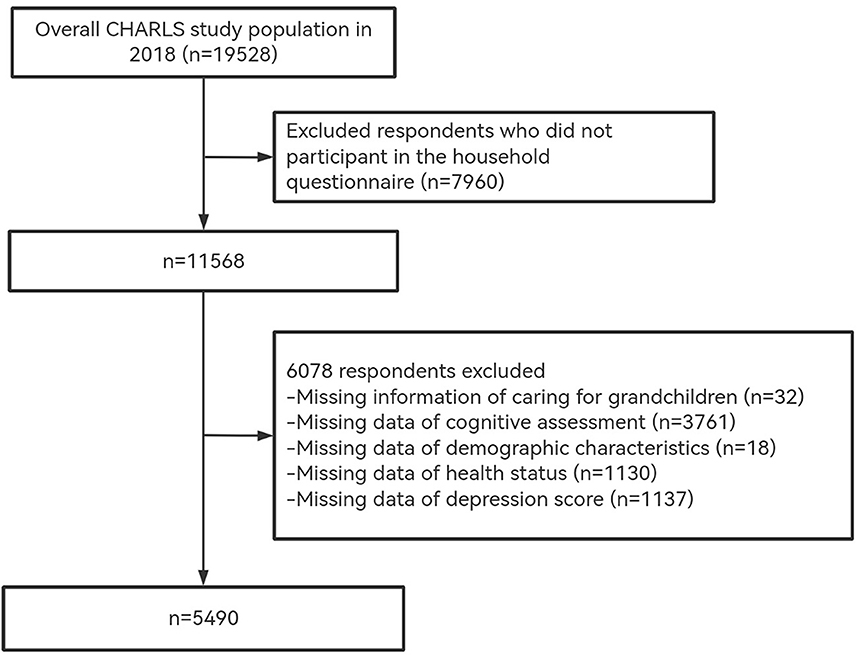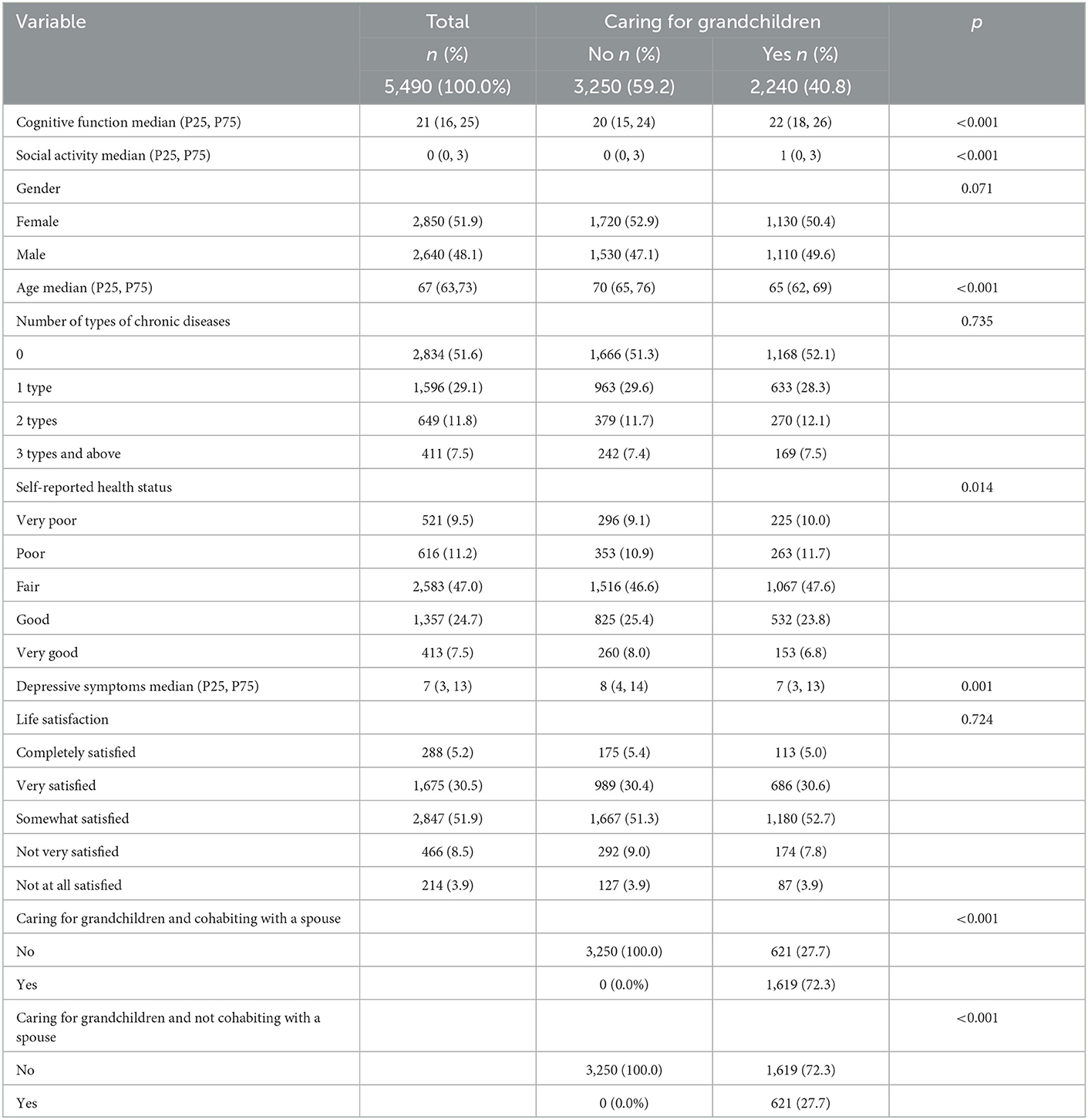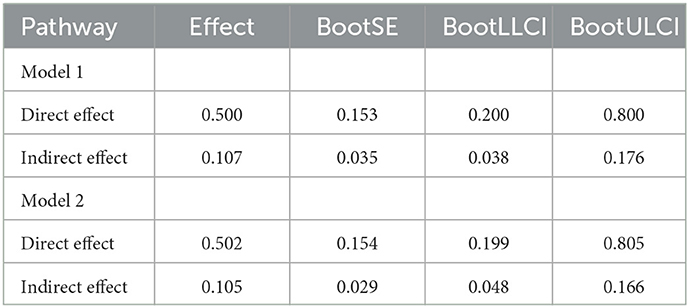- 1School of Nursing, Hubei University of Chinese Medicine, Wuhan, China
- 2Department of Tuina and Rehabilitation Medicine, Hubei Provincial Hospital of Traditional Chinese Medicine, Wuhan, China
- 3Department of Tuina and Rehabilitation Medicine, Affiliated Hospital of Hubei University of Chinese Medicine, Wuhan, China
- 4Department of Tuina and Rehabilitation Medicine, Hubei Institute of Traditional Chinese Medicine, Wuhan, China
- 5First Clinical Medical College, Hubei University of Chinese Medicine, Wuhan, China
Introduction: In the context of an aging population and age-related conditions increasing, the increasing number of middle-aged and older adults are involved in grandchildren care. This study aimed to 1) explore the association between caring for grandchildren based on living arrangements and cognitive function among Chinese middle-aged and older adults; and 2) investigate the mediating roles of social activities and depressive symptoms in the aforementioned association.
Methods: This study selected 5490 Chinese people (≥45 years old) from the 2018 China Health and Retirement Longitudinal Study (CHARLS). Participants answered questions related to socio-demographics, the Mini-mental State Examination, the intensity of grandchildren care, the Center for Epidemiological Studies Depression Scale, and social activity.
Results: The results showed that caring for grandchildren and cohabiting with a spouse was positively associated with cognitive function among Chinese middle-aged and older adults (B = 0.829, p < 0.001). Furthermore, there was a positive association between providing intensive or no-intensive grandchildren care and cognitive function. In contrast, caring for grandchildren but not cohabiting with a spouse was negatively associated with cognitive function (B = −0.545, p < 0.05). Moreover, directly and indirectly, caring for grandchildren was significantly associated with cognitive function among Chinese middle-aged and older adults, as mediated by social activities and depressive symptoms.
Discussion: The findings emphasize that living arrangements, social engagement, and psychological health could be considered when encouraging grandparent care as formal care.
1. Background
Population aging is of significant importance, which leads to a substantial increase in age-related conditions, with far-reaching implications for individuals, society, and the economy, such as cognitive decline (1, 2). Approximately 50 million people worldwide are affected by dementia, and nearly 10 million new cases are increasing yearly, which is forecasted to triple by 2050 (3). One study predicts that the dementia population will reach 23.3 million by 2030, and the total cost of dementia is expected to reach $114.2 billion in China (4). Cognitive impairment has become a severe public health problem, placing a heavy burden on the family and society and posing significant challenges to economic development and geriatric care (5). Therefore, finding a solution to this public health issue is urgent. Growing evidence shows that caring for grandchildren is vital in exploring solutions to this problem (6–10).
With the global population aging (11), more and more older adults take on caring for grandchildren obligations (9). In a study of 10 European countries, approximately half of the grandparents provide care for their grandchildren (12). A study shows that 39% of grandparents have responsibilities for the primary caregiving of their grandchildren in the United States (13). Caring for grandchildren is also one of the necessary forms of diversified family structures and functions in China. Statistics from China Longitudinal Aging Social Survey (CLASS) 2014 suggest that 40% of older people are involved in caring for their grandchildren (14). Furthermore, some researchers proposed that providing grandchildren care positively affected cognitive function (6–10). Nevertheless, some studies also found that grandparents who provided more intensive grandchildren care showed lower cognitive scores (15, 16). Relevant studies available in Chinese people suggested that grandchildren caregiving was positively associated with cognition (7, 8). Although more attention is paid to the link between caring for grandchildren and cognitive function, the underlying mechanism still needs further exploration.
The relationship between caring for grandchildren and cognitive function may be related to social activities and depression, thus affecting cognitive function. In previous research, one study of 24 Spanish grandmothers aged 60 and over interviewers showed that, in most cases, caring for grandchildren could increase their daily activities (17). Some studies also found that caring for grandchildren could reduce grandparents' depressive symptoms (18, 19). Furthermore, numerous studies have demonstrated that older adults who are more socially engaged have higher cognitive function than those with less social engagement (20–23). In addition, some studies showed that depression was associated with an increased risk of cognitive decline (24, 25). However, the relationship and action path among depressive symptoms, social activities, caring for grandchildren, and cognition remained unknown and need further highlighting the significance of exploring the association between them.
Given this, the present study aimed to (1) explore the association between caring for grandchildren based on living arrangements and cognitive function among Chinese middle-aged and older adults and (2) investigate the mediating roles of social activities and depressive symptoms in the aforementioned association. In total, one direct path and two indirect paths were hypothesized in this study (Figure 1). Particularly, caring for grandchildren would be associated with cognitive function among Chinese middle-aged and older adults. In addition, it was expected that social activities and depressive symptoms would mediate the relationship between caring for grandchildren and cognitive function.
2. Materials and methods
2.1. Study sample
Data for this study were extracted from the China Health and Retirement Longitudinal Study (CHARLS) (26), which was a nationally representative longitudinal survey hosted by Peking University. The national baseline survey for CHARLS was conducted in 2011 with 17,708 individual participants from 150 counties of 28 provinces. It has been followed up every 2 to 3 years with a Probability Proportional to Size (PPS) method, targeting residents aged 45 and above in randomly selected households and including the assessments of the social, economic, and health circumstances. The CHARLS aims to collect a set of high-quality microdata representative of Chinese households and individuals aged 45 and older to meet scientific and policy research needs on aging-related issues (26).
Our study used data from the CHARLS 2018 survey, including 19,528 respondents. We selected 5,490 valid participants according to the following criteria: (1) aged 45 and older; (2) provided information about caring for grandchildren; (3) completed cognitive assessments; (4) provided sociodemographic information, physical, and psychological health status. The sample selection process is shown in Figure 2.
2.2. Variables
2.2.1. Dependent variable
The cognitive function is measured by the Chinese version of the Mini-mental State Examination (MMSE) (27). The Chinese version of MMSE has shown sufficient reliability and validity in the Chinese population and has been widely used in China for the clinical diagnosis of cognitive impairment (interrater correlation coefficient = 0.998) (28, 29). The MMSE consists of 24 items that assess orientation, episodic memory, attention and computational power, language, and visuospatial processing. The total score ranges from 0 to 30, with higher scores representing better cognitive function (30). In the CHARLS 2018, orientation is measured by time (day, month, year, season, and date of the week) and location (state, county, city or town, floor of the building, and name of the place) identification, ranging from 0 to 10 points. Episodic memory is tested using the immediate and delayed word recall methods, ranging from 0 to 6 points. The attention and computational power are assessed by asking participants to calculate 100 minus seven and keep minus seven continuously five times (0–5 points). Language skills are measured by naming objectives, repeating a sentence, following orders, reading skills, and writing a sentence (0–8 points). The visual construct is measured by redrawing a picture accurately, which had been displayed previously (0–1 point).
2.2.2. Independent variable
Caring for grandchildren based on living arrangements is classified as caring for grandchildren and cohabiting with a spouse and caring for grandchildren not cohabiting with a spouse. Caring for grandchildren is measured by the following questions in the CHARLS 2018 questionnaire: (1) During last year, did you or your spouse spend time taking care of your grandchildren? It takes the value of 1 if caregiving is provided and 0 if it is not or if there are no grandchildren. (2) How many hours per week did you take care of your grandchildren? The intensity of grandchildren care is measured by categorical variables: none (0 h), non-intensive grandchild care (1–39 h), and intensive grandchild care (≥40 h) (18).
2.2.3. Mediating variable
The mediating variables of this study are social activities and depressive symptoms. According to CHARLS 2018, social activities were defined as the following 11 activities in the questionnaire that respondents are involved. The frequency of participation in social events is determined by asking the respondents, “How often did you do these activities in the last month?” It takes a value of 1 if the answer is not regular; almost every week assigns a value of 2; and almost daily assigns a value of 3. Social activity intensity is measured by adding up the total score for the frequency of participation in each social activity. If not attending any social activities, it takes a value of 0. The range of frequency of social activities is from 0 to 33. Depressive symptoms are evaluated by the 10-item Center for Epidemiological Studies Depression Scale (CES-D) (31). Existing studies have shown that CES-D has good validity and reliability and CES-D can effectively measure depression levels in Chinese middle-aged and older adults (Cronbach's alpha =0.815) (32, 33). Each item uses a 4-point Likert scale. The four options are “rarely or none of the time (< 1 day),” “some or a little of the time (1–2 days),” “occasionally or a moderate amount of the time (3–4 days),” and “most or all of the time (5–7 days).” Negative symptoms are assigned as 0, 1, 2, and 3 in turn. On the contrary, two positive symptoms take values of 3, 2, 1, and 0. The scale's score is between 0 and 30, with higher scores indicating high depressive symptoms.
2.2.4. Control variables
Control variables are added to this study, including age (≥45 years); gender (female = 0, male = 1); the number of types of chronic diseases was measured by whether the respondent reported having the following chronic diseases: hypertension, dyslipidemia, diabetes or high blood sugar, cancer or malignant tumor, chronic lung disease, heart problem, liver disease, kidney disease, stomach or other digestive diseases, stroke, memory-related disease, psychiatric problem, arthritis or rheumatism, and asthma (none = 0; one type of chronic disease = 1; two types of chronic disease = 2; and three types of chronic disease and above = 3); self-reported health status (very poor = 1, poor = 2, fair = 3, good = 4, and very good = 5); and life satisfaction (completely satisfied = 5, very satisfied = 4, somewhat satisfied = 3, not very satisfied = 2, and not at all satisfied = 1).
2.3. Data analysis
In this study, all the data analyses and processing were carried out using the IBM SPSS Statistics version 25 (Armonk, NY: IBM Corp). Mann–Whitney U-test was performed to test the differences of respondents between providing grandchildren care and non-providing grandchildren care. Multivariate linear regression analysis was performed to examine the association between caring for grandchildren based on living arrangements and cognitive function among Chinese middle-aged and older adults. Finally, the bootstrap method was used to analyze the mediation effects of social activities and depressive symptoms between caring for grandchildren and cognitive function. P < 0.05 was considered statistically significant.
3. Results
3.1. Basic characteristics of the respondents
Table 1 reports the basic characteristics of the whole respondents and the comparison of non-caregivers' and caregivers' subgroups. Of the entire participants, the median age of participants was 67 years old. The median score for cognitive was 21, and the median for depressive symptoms was 7. Moreover, most participants had no chronic diseases (51.6%), 51.9% of participants were somewhat satisfied with life, and 47.0% of participants reported that their health status was fair.
There were significant differences between non-caregivers and caregivers in most characteristics. The median age of those providing grandchildren care was 65 years old. Overall, 40.8% of grandparents provided grandchildren care. Among these participants, those who provided grandchildren care most cohabited with a spouse (72.3%). Moreover, the differences in cognitive function and depressive symptoms between caregivers and non-caregivers were statistically significant (P < 0.001). Compared with non-caregivers, caregivers scored significantly higher in cognitive function and a lower rate of depressive symptoms. Furthermore, social activities and self-reported health status significantly differed between non-caregivers and caregivers.
3.2. Relationship between caring for grandchildren based on living arrangements and cognitive function
As shown in Table 2, after controlling the confounding variables, caring for grandchildren and cohabiting with a spouse were positively associated with cognitive function among Chinese middle-aged and older adults (B = 0.829, p < 0.001). By contrast, caring for grandchildren but not cohabiting with a spouse was negatively associated with cognitive function among Chinese middle-aged and older adults (B = −0.545, p < 0.05).
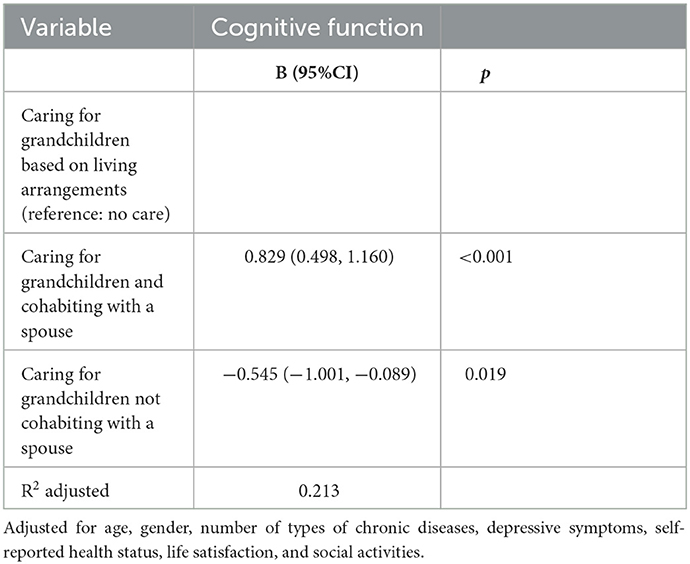
Table 2. Regression results of caring for grandchildren based on living arrangements and cognitive function.
3.3. Relationship between the intensity of caring for grandchildren based on living arrangements and cognitive function
As shown in Table 3, for those participants who cohabited with a spouse, the provision of intensive grandchildren care was more likely associated with an increase in cognitive function than those providing no grandchildren care or non-intensive grandchildren care (B = 0.843, p < 0.001).
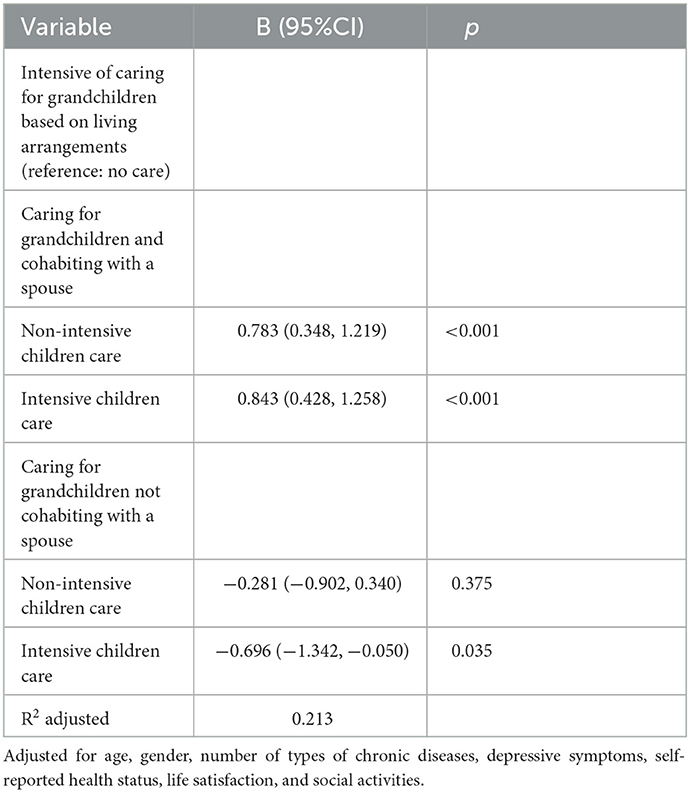
Table 3. Regression results of the intensity of caring for grandchildren based on living arrangements and cognitive function.
On the contrary, providing intensive grandchildren care and not cohabiting with a spouse was negatively associated with cognitive function (B = −0.696, p < 0.05). Nevertheless, providing non-intensive grandchildren care and not cohabiting with a spouse did not pass the statistical significance test. The regression coefficient was negative, indicating a harmful effect on the caregiver's cognitive function (B = −0.281, p = 0.375).
3.4. Mediation effect test
In Table 4, model 1 showed that the upper and lower bounds of the bootstrap 95% confidence interval of the social activities' effect did not contain 0, so it is considered that social activities played a mediating role between caring for grandchildren and cognitive function. Model 2 showed that the upper and lower bounds of the bootstrap 95% confidence interval of the depressive symptoms' effect did not contain 0, so there was also a mediating effect of depressive symptoms between caring for grandchildren and cognitive function.
In Figure 3, model 1 shows that there was a positive association between caring for grandchildren and cognitive function without mediating variables (B = 0.608, p < 0.001). After adding social activities as the mediating variable into the model, caring for grandchildren was still positively associated with cognitive function among Chinese middle-aged and older adults (B = 0.500, p < 0.01). In Figure 3, model 1 also reported that caring for grandchildren was positively associated with social activities (B = 0.204, p < 0.01). Moreover, there was a positive association between social activities and cognitive function (B = 0.526, p < 0.001), which meant the higher frequency of social engagement, the better cognitive function.
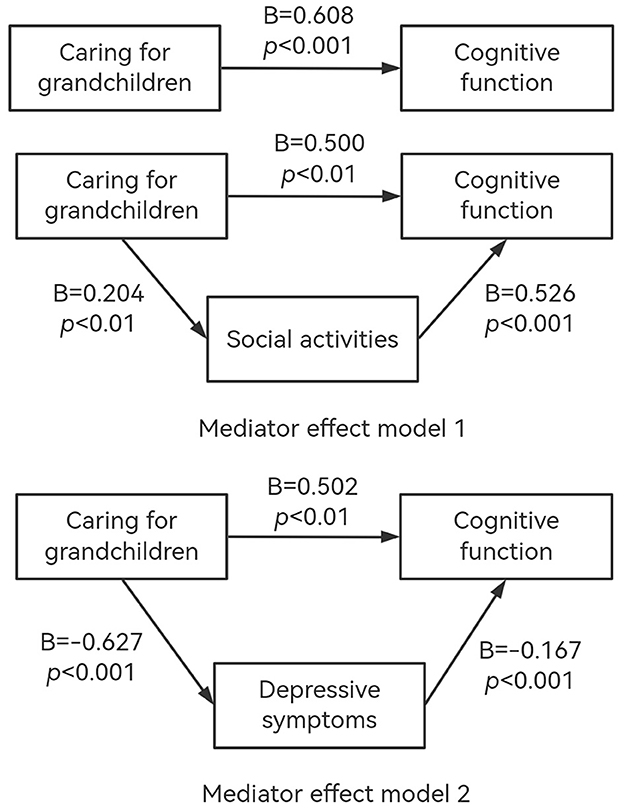
Figure 3. The conceptional framework of the mediation models. All models were adjusted for age, gender, number of types of chronic diseases, self-reported health status, life satisfaction.
As shown in Figure 3, model 2, when depressive symptoms were added as a mediating variable, caring for grandchildren still had a significant positive association with cognitive function (B = 0.502, p < 0.01). Moreover, caring for grandchildren was negatively associated with depressive symptoms (B = −0.627, p < 0.001). Depressive symptoms had a significant negative association with cognitive function (B = −0.167, p < 0.001), which meant the lower scored depressive symptoms, the higher scored cognitive function.
Therefore, the social activities and depressive symptoms partially mediated the relationship between caring for grandchildren and cognitive function among Chinese middle-aged and older adults.
4. Discussion
Our findings showed that grandparents who provided intensive grandchildren care and cohabited with a spouse were more positively associated with cognitive function than those who provided no grandchildren care or non-intensive grandchildren care. Moreover, social activities and depressive symptoms partially mediated the relationship between caring for grandchildren and cognitive function among Chinese middle-aged and older adults.
This study showed that grandparents played a crucial role in China's childcare system. A total of 40.8% of Chinese middle-aged and older adults provided varying degrees of grandchildren care. The result of this study was similar to those of the studies conducted in CLASS 2014 (14) and Tang's study (34). This trend is due to China's traditional culture and the concept of filial piety. The grandparents have a moral responsibility to their children and grandchildren (35). Moreover, with the high rate of women's labor force participation in China, the conflict between work and childcare for mothers is intense (36). Therefore, Chinese parents need to rely on grandparents to help them balance work and childcare. Furthermore, in rural China, due to the surplus of agricultural labor (35), adult children often migrate to the city for better employment opportunities and leave their children with grandparents (37). In addition, there is a severe lacking of formal daycare facilities for children in China (38).
This study suggested that social activities and depressive symptoms played intermediary roles between caring for grandchildren and cognitive function among Chinese middle-aged and older adults. Our finding was consistent with some studies which showed that providing grandchildren care could reduce depressive symptoms (17, 34, 39). A cohort study showed that depression was a risk factor for dementia (40). A study by Vinkers et al. also found that cognitive impairment was associated with exacerbating depressive symptoms (24). Moreover, some studies showed that caring for grandchildren can promote mental health in older adults (34, 39). Thus, caring for grandchildren could help grandparents get emotional support, reduce depressive symptoms, and improve their cognitive function. Social activities also played a crucial role in the relationship between caring for grandchildren and cognitive function. In agreement with the previous study, our findings demonstrated a higher frequency of engagement in social interaction with a lower risk of cognitive decline (41). Based on the role reinforcement theory, caring for grandchildren as a social role provides grandparents with emotional support from grandchildren and made social connections, gaining social integration and satisfaction from social participation (42, 43). In one pilot RCT, which included social activities as an intervention component, the cognitive function of older adults was significantly improved (44). Another study found that social engagement could be viewed as a cognitively stimulating daily activity (45). Moreover, providing grandchildren care increases grandparents' opportunities for social engagement, gives grandparents more social support, and enhances their emotional health, thus promoting their cognition in social interactions (25, 34).
Caring for grandchildren and cohabiting with a spouse were positively associated with cognitive function among Chinese middle-aged and older adults. Significantly, providing intensive grandchildren care and cohabiting with a spouse were more associated with better cognitive function. Our result is consistent with the earlier studies, which showed that caring for grandchildren was positively associated with cognitive function among Chinese middle-aged and older adults (7, 8). Grandparenting is a perfect example of a social role. Cognition can be maintained due to its upbeat nature (46). Moreover, a study showed that intensive grandchildren care is associated with lower depressive symptoms (18). In addition, a study suggests that older adults without a spouse are at greater risk for depression than those with a spouse (47). The presence of a spouse can facilitate emotional communication and emotional support for older adults, thus counteracting some of the potential risks of depression (34). Empirical research proved that physiological stress and depressive symptoms are the risk factors for cognitive decline (48, 49). Therefore, by cohabiting with a spouse and caring for grandchildren, the spouse could relieve some of the physical and psychological burdens, reduce the risk of depression, and thus improve the cognitive function of the grandchildren's caregivers. In contrast, our findings suggested that caring for grandchildren but not cohabiting with a spouse was associated with a decline in cognitive function of Chinese middle-aged and older adults. A European study highlighted that intensively engaged in grandchildren care had lower cognitive function than others (16). It can be physically and psychologically demanding to help another person with daily activities (46), which may increase caregivers' stress and limit their social engagement, thus negatively affecting cognitive function (15).
The present study has certain limitations. This research uses cross-sectional data and cannot identify the causal relationship. The CHARLS questionnaire cannot determine the grandparent and grandchildren's living situation. It is impossible to analyze intergenerational caregiving's effect on caregivers' cognition in intergenerational families. Moreover, caregiver status is defined by the hours per week spent caring for grandchildren and whether the caregiver cohabited with a spouse. However, due to the database limitation, no distinction is made between co-parenting caregivers and guardians and between participating caregivers and primary caregivers. In addition, the MMSE is a self-reported screening scale, and a clinical diagnosis of cognitive impairment is unavailable. Also, there might be other potential mediators or moderators that could be further examined in future studies, for example, the parent's role in the family, the intergenerational support from children, and family cohesion.
5. Conclusion
This study provides evidence of the association between caring for grandchildren based on living arrangements and cognitive function among Chinese middle-aged and older adults, and it also suggests that social activities and depressive symptoms mediate the relationship between caring for grandchildren and cognitive function. The present study highlighted that caring for grandchildren and cohabiting with a spouse are positively associated with cognitive function among Chinese middle-aged and older adults. Providing intensive grandchildren care and cohabiting with a spouse are more significantly associated with better cognitive function. The findings emphasize that living arrangements, social engagement, and psychological health could be considered when encouraging grandparent care as formal care.
Data availability statement
The datasets presented in this study can be found in online repositories. The names of the repository/repositories and accession number(s) can be found in the article/supplementary material.
Ethics statement
The studies involving human participants were reviewed and approved by Ethical Review Committee of Peking University. The patients/participants provided their written informed consent to participate in this study. Written informed consent was obtained from the individual(s) for the publication of any potentially identifiable images or data included in this article.
Author contributions
XH, GQ, JZ, and YX designed and conducted research. XH and YX analyzed data and wrote the manuscript. JZ and GQ revised the paper and had primary responsibility for the final content. All authors revised it critically for important intellectual content.
Acknowledgments
The authors thank all participants of the National School of Development Workshop at Peking University for their efforts in the China Health and Retirement Longitudinal Study (CHARLS) of 2018.
Conflict of interest
The authors declare that the research was conducted in the absence of any commercial or financial relationships that could be construed as a potential conflict of interest.
Publisher's note
All claims expressed in this article are solely those of the authors and do not necessarily represent those of their affiliated organizations, or those of the publisher, the editors and the reviewers. Any product that may be evaluated in this article, or claim that may be made by its manufacturer, is not guaranteed or endorsed by the publisher.
References
1. Post LA, Swierenga SJ, Oehmke J, Salmon C, Prokhorov A, Meyer E, et al. The implications of an aging population structure. Int J Interdiscip Soc Sci. (2006) 1:47–58. doi: 10.18848/1833-1882/CGP/v01i02/52353
2. Mendis SB, Raymont V, Tabet N. Bilingualism: a global public health strategy for healthy cognitive aging. Front Neurol. (2021) 12:512. doi: 10.3389/fneur.2021.628368
3. World Health Organization. Risk Reduction of Cognitive Decline and Dementia: WHO Guidelines. World Health Organization (2019).
4. Xu J, Wang J, Wimo A, Fratiglioni L, Qiu C. The economic burden of dementia in China, 1990–2030: implications for health policy. B World Health Organ. (2017) 95:18. doi: 10.2471/BLT.15.167726
5. Liu D, Cheng G, An L, Gan X, Wu Y, Zhang B, et al. Public knowledge about dementia in China: a national WeChat-based survey. Int J Environ Res Public Health. (2019) 16:4231. doi: 10.3390/ijerph16214231
6. Bertrand RM, Saczynski JS, Mezzacappa C, Hulse M, Ensrud K, Fredman L. Caregiving and cognitive function in older women: evidence for the healthy caregiver hypothesis. J Aging Health. (2012) 24:48–66. doi: 10.1177/0898264311421367
7. Liao S, Qi L, Xiong J, Yan J, Wang R. Intergenerational ties in context: association between caring for grandchildren and cognitive function in middle-aged and older Chinese. Int J Environ Res Public Health. (2021) 18:21. doi: 10.3390/ijerph18010021
8. Wang S, Zhang S. Influence of skip- generation care offering on cognitive function of middle aged and elderly people ——an analysis based on propensity matched technique. Popul J. (2021) 43:60–71. doi: 10.16405/j.cnki.1004-129X.2021.03.006
9. Ahn T, Choi KD. Grandparent caregiving and cognitive functioning among older people: evidence from Korea. Rev Econ Household. (2019) 17:553–86. doi: 10.1007/s11150-018-9413-5
10. Sneed RS, Schulz R. Grandparent caregiving, race, and cognitive functioning in a population-based sample of older adults. J Aging Health. (2019) 31:415–38. doi: 10.1177/0898264317733362
11. Lutz W, Sanderson W, Scherbov S. The coming acceleration of global population ageing. Nature. (2008) 451:716–9. doi: 10.1038/nature06516
12. Hank K, Buber I. Grandparents caring for their grandchildren: findings from the 2004 survey of health, ageing, and retirement in Europe. J Fam Issues. (2009) 30:53–73. doi: 10.1177/0192513X08322627
13. Chen F, Mair CA, Bao L, Yang YC. Race/ethnic differentials in the health consequences of caring for grandchildren for grandparents. J Gerontol Series B: Psychol Sci Soc Sci. (2015) 70:793–803. doi: 10.1093/geronb/gbu160
14. Song L, Yang L, Peng X. The quantitative study of relationships between grandparenting and health outcome and implications for public policy. Popul J. (2020) 42:55–69. doi: 10.16405/j.cnki.1004-129X.2020.01.005
15. Burn KF, Henderson VW, Ames D, Dennerstein L, Szoeke C. Role of grandparenting in postmenopausal women's cognitive health: results from the women's healthy aging project. Menopause. (2014) 21:1069–74. doi: 10.1097/GME.0000000000000236
16. Arpino B, Bordone V. Does grandparenting pay off? The effect of child care on grandparents' cognitive functioning. J Marriage Fam. (2014) 76:337–51. doi: 10.1111/jomf.12096
17. Villar F, Celdrán M, Triadó C. Grandmothers offering regular auxiliary care for their grandchildren: an expression of generativity in later life? J Women Aging. (2012) 24:292–312. doi: 10.1080/08952841.2012.708576
18. Kim J, Park EC, Choi Y, Lee H, Lee SG. The impact of intensive grandchild care on depressive symptoms among older Koreans. Int J Geriatr Psych. (2017) 32:1381–91. doi: 10.1002/gps.4625
19. Grundy EM, Albala C, Allen E, Dangour AD, Elbourne D, Uauy R. Grandparenting and psychosocial health among older Chileans: a longitudinal analysis. Aging Ment Health. (2012) 16:1047–57. doi: 10.1080/13607863.2012.692766
20. Krueger KR, Wilson RS, Kamenetsky JM, Barnes LL, Bienias JL, Bennett DA. Social engagement and cognitive function in old age. Exp Aging Res. (2009) 35:45–60. doi: 10.1080/03610730802545028
21. James BD, Wilson RS, Barnes LL, Bennett DA. Late-life social activity and cognitive decline in old age. J Int Neuropsych Soc. (2011) 17:998–1005. doi: 10.1017/S1355617711000531
22. Thomas PA. Trajectories of social engagement and limitations in late life. J Health Soc Behav. (2011) 52:430–43. doi: 10.1177/0022146511411922
23. Hughes TF, Flatt JD, Fu B, Chang CH, Ganguli M. Engagement in social activities and progression from mild to severe cognitive impairment: the MYHAT study. Int Psychogeriatr. (2013) 25:587–95. doi: 10.1017/S1041610212002086
24. Vinkers DJ, Gussekloo J, Stek ML, Westendorp RG, van der Mast RC. Temporal relation between depression and cognitive impairment in old age: prospective population based study. BMJ-Brit Med J. (2004) 329:881. doi: 10.1136/bmj.38216.604664.DE
25. Wilson RS, De Leon CM, Bennett DA, Bienias JL, Evans DA. Depressive symptoms and cognitive decline in a community population of older persons. J Neurol Neurosurg Psychiatry. (2004) 75:126–9.
26. Zhao Y, Hu Y, Smith JP, Strauss J, Yang G. Cohort profile: the China health and retirement longitudinal study (CHARLS). Int J Epidemiol. (2014) 43:61–8. doi: 10.1093/ije/dys203
27. Folstein MF, Folstein SE, McHugh PR. “Mini-mental state”: a practical method for grading the cognitive state of patients for the clinician. J Psychiatr Res. (1975) 12:189–98. doi: 10.1016/0022-3956(75)90026-6
28. Yi Z, Vaupel JW. Functional capacity and self–evaluation of health and life of oldest old in China. J Soc Issues. (2002) 58:733–48. doi: 10.1111/1540-4560.00287
29. Li G, Shen YC, Chen CH, Zhao YW, Li SR, Lu M. An epidemiological survey of age-related dementia in an urban area of Beijing. Acta Psychiat Scand. (1989) 79:557–63. doi: 10.1111/j.1600-0447.1989.tb10303.x
30. Wei K Liu Y Yang J Gu N Cao X Zhao X Jiang L Li Li C: Living arrangement modifies the associations of loneliness with adverse health outcomes in older adults: evidence from the CLHLS. BMC Geriatr. (2022) 22:59. doi: 10.1186/s12877-021-02742-5
31. Andresen EM, Malmgren JA, Carter WB, Patrick DL. Screening for depression in well older adults: evaluation of a short form of the CES-D. Am J Prev Med. (1994) 10:77–84. doi: 10.1016/S0749-3797(18)30622-6
32. Cheng S, Chan ACM. The center for epidemiologic studies depression scale in older Chinese: thresholds for long and short forms. Int J Geriatr Psych. (2005) 20:465–70. doi: 10.1002/gps.1314
33. Huang Q, Wang X, Chen G. Reliability and validity of 10-item CES-D among middle aged and older adults in China. Chin J Health Psychol. (2015) 7:1036–41. doi: 10.13342/j.cnki.cjhp.2015.07.023
34. Tang S, Yang T, Ye C, Liu M, Gong Y, Yao L, et al. Research on grandchild care and depression of Chinese older adults based on CHARLS2018: the mediating role of intergenerational support from children. BMC Public Health. (2022) 22:1–14. doi: 10.1186/s12889-022-12553-x
35. Chen F, Liu G, Mair CA. Intergenerational ties in context: grandparents caring for grandchildren in China. Soc Forces. (2011) 90:571–94. doi: 10.1093/sf/sor012
36. Aassve A, Arpino B, Goisis A. Grandparenting and mothers' labour force participation: a comparative analysis using the generations and gender survey. Demogr Res. (2012) 27:53–84. doi: 10.4054/DemRes.2012.27.3
37. Xu L, Wu B, Chi I, Hsiao H. Intensity of grandparent caregiving and life satisfaction among rural Chinese older adults: a longitudinal study using latent difference score analysis. Fam Community Health. (2012) 35:287–99. doi: 10.1097/FCH.0b013e31826665d0
38. Chen F, Short SE, Entwisle B. The impact of grandparental proximity on maternal childcare in China. Popul Res Policy Rev. (2000) 19:571–90. doi: 10.1023/A:1010618302144
39. Zhao D, Zhou Z, Shen C, Ibrahim S, Zhao Y, Cao D, et al. Gender differences in depressive symptoms of rural Chinese grandparents caring for grandchildren. BMC Public Health. (2021) 21:1–17. doi: 10.1186/s12889-021-11886-3
40. Dotson VM, Beydoun MA, Zonderman AB. Recurrent depressive symptoms and the incidence of dementia and mild cognitive impairment. Neurology. (2010) 75:27–34. doi: 10.1212/WNL.0b013e3181e62124
41. Barnes LL, De Leon CM, Wilson RS, Bienias JL, Evans DA. Social resources and cognitive decline in a population of older African Americans and whites. Neurology. (2004) 63:2322–6. doi: 10.1212/01.WNL.0000147473.04043.B3
42. Moen P, Robison J, Dempster-McClain D. Caregiving and women's well-being: a life course approach. J Health Soc Behav. (1995) 36:259–73. doi: 10.2307/2137342
43. Xu L, Tang F, Li LW, Dong XQ. Grandparent caregiving and psychological well-being among Chinese American older adults—the roles of caregiving burden and pressure. J Gerontol A Biol Sci Med Sci. (2017) 72:S56–62. doi: 10.1093/gerona/glw186
44. Carlson MC, Saczynski JS, Rebok GW, Seeman T, Glass TA, McGill S, et al. Exploring the effects of an “everyday” activity program on executive function and memory in older adults: Experience Corps®. Gerontologist. (2008) 48:793–801. doi: 10.1093/geront/48.6.793
45. Holtzman RE, Rebok GW, Saczynski JS, Kouzis AC, Wilcox Doyle K, Eaton WW. Social network characteristics and cognition in middle-aged and older adults. J Gerontol B Psychol Sci Soc Sci. (2004) 59:P278–84. doi: 10.1093/geronb/59.6.P278
46. Burn K, Szoeke C. Is grandparenting a form of social engagement that benefits cognition in ageing? Maturitas. (2015) 80:122–5. doi: 10.1016/j.maturitas.2014.10.017
47. Zhang B, Li J. Gender and marital status differences in depressive symptoms among elderly adults: the roles of family support and friend support. Aging Ment Health. (2011) 15:844–54. doi: 10.1080/13607863.2011.569481
48. McEwen BS. Physiology and neurobiology of stress and adaptation: central role of the brain. Physiol Rev. (2007) 87:873–904. doi: 10.1152/physrev.00041.2006
Keywords: cognitive function, social activities, depressive symptoms, living arrangements, caring for grandchildren
Citation: Hou X, Xiong Y, Qiao G and Zhou J (2023) Association between caring for grandchildren based on living arrangements and cognitive function among Chinese middle-aged and older adults: The mediating roles of social activities and depressive symptoms. Front. Public Health 11:1105066. doi: 10.3389/fpubh.2023.1105066
Received: 22 November 2022; Accepted: 16 January 2023;
Published: 14 February 2023.
Edited by:
Wei Liang, Shenzhen University, ChinaReviewed by:
Vahid Rashedi, University of Social Welfare and Rehabilitation Sciences, IranBorui Shang, Hebei Institute of Physical Education, China
Copyright © 2023 Hou, Xiong, Qiao and Zhou. This is an open-access article distributed under the terms of the Creative Commons Attribution License (CC BY). The use, distribution or reproduction in other forums is permitted, provided the original author(s) and the copyright owner(s) are credited and that the original publication in this journal is cited, in accordance with accepted academic practice. No use, distribution or reproduction is permitted which does not comply with these terms.
*Correspondence: Guiyuan Qiao,  Z3VpeXVhbnFpYW8xOTgzQGhidG0uZWR1LmNu; Jing Zhou,
Z3VpeXVhbnFpYW8xOTgzQGhidG0uZWR1LmNu; Jing Zhou,  emhvdWppbmdAaGJodGNtLmNvbQ==
emhvdWppbmdAaGJodGNtLmNvbQ==
†These authors share first authorship
 Xuebei Hou
Xuebei Hou Yuan Xiong2,3,4†
Yuan Xiong2,3,4†